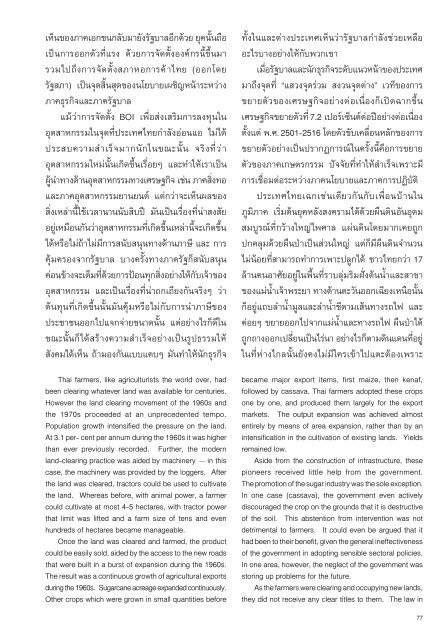บ้านเรือนถิ่นไทยในช่วงเจ็ดทศวรรษ 2489-2559
You also want an ePaper? Increase the reach of your titles
YUMPU automatically turns print PDFs into web optimized ePapers that Google loves.
เห็นของภาคเอกชนกลับมายังรัฐบาลอีกด้วย ยุคนั้นถือ<br />
เป็นการออกตัวที่แรง ด้วยการจัดตั้งองค์กรนี้ขึ้นมา<br />
รวมไปถึงการจัดตั้งสภาหอการค้าไทย (ออกโดย<br />
รัฐสภา) เป็นจุดสิ้นสุดของนโยบายเผชิญหน้าระหว่าง<br />
ภาคธุรกิจและภาครัฐบาล<br />
แม้ว่าการจัดตั้ง BOI เพื่อส่งเสริมการลงทุนใน<br />
อุตสาหกรรมในจุดที่ประเทศไทยกำลังอ่อนแอ ไม่ได้<br />
ประสบความสำเร็จมากนักในขณะนั้น จริงที่ว่า<br />
อุตสาหกรรมใหม่นั้นเกิดขึ้นเรื่อยๆ และทำให้เราเป็น<br />
ผู้นำทางด้านอุตสาหกรรมทางเศรษฐกิจ เช่น ภาคสิ่งทอ<br />
และภาคอุตสาหกรรมยานยนต์ แต่กว่าจะเห็นผลของ<br />
สิ่งเหล่านี้ใช้เวลานานนับสิบปี มันเป็นเรื่องที่น่าสงสัย<br />
อยู่เหมือนกันว่าอุตสาหกรรมที่เกิดขึ้นเหล่านี้จะเกิดขึ้น<br />
ได้หรือไม่ถ้าไม่มีการสนับสนุนทางด้านภาษี และ การ<br />
คุ้มครองจากรัฐบาล บางครั ้งทางภาครัฐก็สนับสนุน<br />
ค่อนข้างจะเต็มที่ด้วยการป้อนทุกสิ่งอย่างให้กับเจ้าของ<br />
อุตสาหกรรม และเป็นเรื่องที่น่าถกเถียงกันจริงๆ ว่า<br />
ต้นทุนที่เกิดขึ้นนั้นมันคุ้มหรือไม่กับการนำภาษีของ<br />
ประชาชนออกไปแจกจ่ายขนาดนั้น แต่อย่างไรก็ดีใน<br />
ขณะนั้นก็ได้สร้างความสำเร็จอย่างเป็นรูปธรรมให้<br />
สังคมได้เห็น ถ้ามองกันแบบแคบๆ มันทำให้นักธุรกิจ<br />
Thai farmers, like agriculturists the world over, had<br />
been clearing whatever land was available for centuries.<br />
However the land clearing movement of the 1960s and<br />
the 1970s proceeded at an unprecedented tempo.<br />
Population growth intensified the pressure on the land.<br />
At 3.1 per- cent per annum during the 1960s it was higher<br />
than ever previously recorded. Further, the modern<br />
land-clearing practice was aided by machinery – in this<br />
case, the machinery was provided by the loggers. After<br />
the land was cleared, tractors could be used to cultivate<br />
the land. Whereas before, with animal power, a farmer<br />
could cultivate at most 4-5 hectares, with tractor power<br />
that limit was lifted and a farm size of tens and even<br />
hundreds of hectares became manageable.<br />
Once the land was cleared and farmed, the product<br />
could be easily sold, aided by the access to the new roads<br />
that were built in a burst of expansion during the 1960s.<br />
The result was a continuous growth of agricultural exports<br />
during the 1960s. Sugarcane acreage expanded continuously.<br />
Other crops which were grown in small quantities before<br />
ทั้งในและต่างประเทศเห็นว่ารัฐบาลกำลังช่วยเหลือ<br />
อะไรบางอย่างให้กับพวกเขา<br />
เมื่อรัฐบาลและนักธุรกิจระดับแนวหน้าของประเทศ<br />
มาถึงจุดที่ “แสวงจุดร่วม สงวนจุดต่าง” เวทีของการ<br />
ขยายตัวของเศรษฐกิจอย่างต่อเนื่องก็เปิดฉากขึ ้น<br />
เศรษฐกิจขยายตัวที่ 7.2 เปอร์เซ็นต์ต่อปีอย่างต่อเนื่อง<br />
ตั้งแต่ พ.ศ. 2501-2516 โดยตัวขับเคลื่อนหลักของการ<br />
ขยายตัวอย่างเป็นปรากฏการณ์ในครั ้งนี้คือการขยาย<br />
ตัวของภาคเกษตรกรรม ปัจจัยที่ทำให้สำเร็จเพราะมี<br />
การเชื่อมต่อระหว่างภาคนโยบายและภาคการปฏิบัติ<br />
ประเทศไทยเฉกเช่นเดียวกันกับเพื่อนบ้านใน<br />
ภูมิภาค เริ่มต้นยุคหลังสงครามได้ด้วยผืนดินอันอุดม<br />
สมบูรณ์ที่กว้างใหญ่ไพศาล แผ่นดินโดยมากเคยถูก<br />
ปกคลุมด้วยผืนป่าเป็นส่วนใหญ่ แต่ก็มีผืนดินจำนวน<br />
ไม่น้อยที่สามารถทำการเพาะปลูกได้ ชาวไทยกว่า 17<br />
ล้านคนอาศัยอยู่ในพื้นที่ราบลุ่มริมฝั่งต้นน ้ำและสาขา<br />
ของแม่น้ำเจ้าพระยา ทางด้านตะวันออกเฉียงเหนือนั้น<br />
ก็อยู่แถบลำน้ำมูลและลำน้ำชีตามเส้นทางรถไฟ และ<br />
ค่อยๆ ขยายออกไปจากแม่น้ำและทางรถไฟ ผืนป่าได้<br />
ถูกถางออกเปลี่ยนเป็นไร่นา อย่างไรก็ตามดินแดนที่อยู่<br />
ในที่ห่างไกลนั้นยังคงไม่มีใครเข้าไปแตะต้องเพราะ<br />
became major export items, first maize, then kenaf,<br />
followed by cassava. Thai farmers adopted these crops<br />
one by one, and produced them largely for the export<br />
markets. The output expansion was achieved almost<br />
entirely by means of area expansion, rather than by an<br />
intensification in the cultivation of existing lands. Yields<br />
remained low.<br />
Aside from the construction of infrastructure, these<br />
pioneers received little help from the government.<br />
The promotion of the sugar industry was the sole exception.<br />
In one case (cassava), the government even actively<br />
discouraged the crop on the grounds that it is destructive<br />
of the soil. This abstention from intervention was not<br />
detrimental to farmers. It could even be argued that it<br />
had been to their benefit, given the general ineffectiveness<br />
of the government in adopting sensible sectoral policies.<br />
In one area, however, the neglect of the government was<br />
storing up problems for the future.<br />
As the farmers were clearing and occupying new lands,<br />
they did not receive any clear titles to them. The law in<br />
77


















